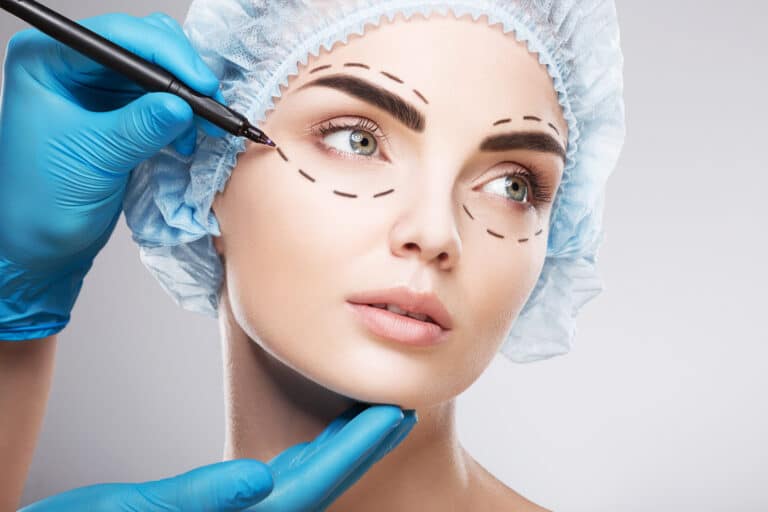Plastic surgery involves repairing or reconstructing part of the body for cosmetic or medical reasons. There were 15.6 million cosmetic procedures and 6.8 million reconstructive procedures in 2020 alone.1 This was despite surgeons reporting an average of eight weeks of downtime due to COVID.
The top three cosmetic procedures were nose reshaping, eyelid surgery, and face-lifts. People had reconstructive procedures for tumor removals, laceration repairs, and other reconstructive reasons.
The popularity of plastic surgery continues to rise, and the practice isn’t as new as one might think, given the technologically advanced equipment available today. It has a long history and a bright future.
When Did Plastic Surgery Start?
The plastic surgery timeline starts with its name. It has nothing to do with the use of plastics. Plastike is a Greek word meaning the art of modeling or sculpting.2
The practice can be traced back to 800 BC in India when practitioners used reformed flaps of skin from the forehead to replace amputated noses. The ancient Romans and Greeks used plastic surgery to correct defects around the lips and ears and to enhance the skin. Plastic surgery has been with us ever since.
The Early Periods of Plastic Surgery
There were periods here and there when plastic surgery wasn’t common due to societal taboos. But by the 1700s, it gained steam again in response to helping wounded soldiers.3 Modern weapons resulted in more gruesome injuries, including to the face and head. Surgeons were challenged to find ways to help soldiers live better after returning home.
Surgeons also began to realize around this time the effect of one’s appearance on emotional well-being and future success. They started to think more about using plastic surgery for cosmetic rather than just reconstructive reasons. Advances in anesthesia and preventing infections let surgeons expand their procedures even further.
In 1827, a doctor performed the first cleft palate operation in the United States. By the early 1900s, plastic surgery was recognized as its own specialty. Board certification and a plastic surgery medical journal followed in the 1950s.
These advances led to an increase in the legitimacy of plastic surgery for both patients and for doctors who chose it as their specialty.
The Continued Evolution of Plastic Surgery
By the 1960s and 70s in the United States, plastic surgeons performed breast augmentations, rhinoplasties, face-shaping, and other cosmetic procedures.4 The focus for most plastic surgeons was still reconstructive surgery, but more turned toward cosmetic procedures to meet increasing demand. Botox, initially used to treat crossed eyes, became a skin-smoothing method in the 1970s.
By the 1990s, doctors were performing more cosmetic than reconstructive plastic surgeries. By 2005, the number of cosmetic procedures was more than double that of other plastic surgeries.
Plastic Surgery Today
Advances in technology have led to more possibilities in plastic surgery. Surgeons can now perform Brazilian butt lifts, where fat is taken from other body parts to make the buttocks more round and curvy. Tummy tucks, body contouring, eyelid reshaping, liposuction, and other procedures are all on the table.
Safety advancements have also contributed to this rise in different procedures and surgeon abilities. While there is always a danger with any surgery, especially those using anesthesia, plastic surgery is considered safe when the doctor is board-certified.5 Most people find that the benefits of plastic surgery outweigh the risks involved.
Where Is Plastic Surgery Heading?
There are many areas in which plastic surgery still has room to grow. Stem cell technology opens the possibility of more compatible fillers that last longer.6 Stem cell harvesting may also lead to a way to regenerate cells and tissues and encourage the growth of new body parts. Stem cell research could also lead to skin regeneration for burn victims, hand and face transplants, and other innovations.
Plastic surgeons of the future may also be able to help people reduce fat using advances in current techniques, such as CoolScuplting, that don’t require incisions. There are also professionals researching ways to delay the skin’s aging process by slowing down collagen breakdown and fighting other skin and soft tissue changes.
The continued popularity of plastic surgery ensures that researchers will continue to look at ways to improve current techniques and develop new ones. Whether for cosmetic or reconstructive purposes, cosmetic surgery is here to stay.
Learn More About Plastic Surgery and Other Ways To Treat Your Body
Understanding how we have treated our bodies throughout history is crucial to making good choices now and blazing a path to the future of plastic surgery. To learn more about plastic surgery and other treatments for your skin or body, visit My Body Treatment. We offer a variety of comprehensive, physician-reviewed articles and guides to help you learn more about your body and identify the symptoms of common conditions and the treatments suitable for each.
SOURCES:
- American Society of Plastic Surgeons: “Plastic Surgery Statistics Report.”
- American Society of Plastic Surgeons: “How Plastic Surgeons Got Their Name.”
- VeryWell Health: “The History of Plastic Surgery.”
- CNN: “From Ancient Egypt to Beverly Hills: A Brief History of Plastic Surgery.“
- Cleveland Clinic: “Plastic Surgery.”
- North Downs Hospital: “The Future of Cosmetic Surgery.”





